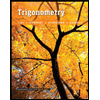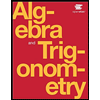Part I- Proofs (1) We will later learn an identity that states sin(x + y) = sinxcosy + sinycosx. Use this identity to prove that sin(t + 2rn) = sin t, for any integer n and any real number t. (2) Another identity states that cos(x + y) = cosxcosy – sinxsiny. Use this identity to prove that cos(t + 2nn) = cos t, for any integer n and any real number t. Part II – Conceptual Questions (1) Explain why the tangent of an angle whose terminal side lies in the third quadrant will always have a positive value. (2) An angle, measured in radians, has its terminal side in the second quadrant. What is the complement of this angle? What is the supplement? Explain your answers.
Part I- Proofs (1) We will later learn an identity that states sin(x + y) = sinxcosy + sinycosx. Use this identity to prove that sin(t + 2rn) = sin t, for any integer n and any real number t. (2) Another identity states that cos(x + y) = cosxcosy – sinxsiny. Use this identity to prove that cos(t + 2nn) = cos t, for any integer n and any real number t. Part II – Conceptual Questions (1) Explain why the tangent of an angle whose terminal side lies in the third quadrant will always have a positive value. (2) An angle, measured in radians, has its terminal side in the second quadrant. What is the complement of this angle? What is the supplement? Explain your answers.
Trigonometry (11th Edition)
11th Edition
ISBN:9780134217437
Author:Margaret L. Lial, John Hornsby, David I. Schneider, Callie Daniels
Publisher:Margaret L. Lial, John Hornsby, David I. Schneider, Callie Daniels
Chapter1: Trigonometric Functions
Section: Chapter Questions
Problem 1RE:
1. Give the measures of the complement and the supplement of an angle measuring 35°.
Related questions
Question
please solve, show all steps, and explain

Transcribed Image Text:Part III – Application
Charleston, South Carolina (33° 47' 5" N) and Toronto, Ontario (43° 39' 4" N) lie on the
same line of longitude. These lines are referred to as Great Circles of the earth.
(1) Draw a diagram to depict this information.
(2) Find the difference between the angles in degrees, minutes, and seconds.
(3) Convert your answer from (2) to decimal degrees (round to 4 decimal places).
(4) Convert your answer from (3) to radian measure (round to 4 decimal places).
(5) Assuming the radius of the earth is 3960 miles, find the distance between
Charleston, South Carolina and Toronto, Ontario. Give your answer to the nearest
mile.

Transcribed Image Text:Part I– Proofs
(1) We will later learn an identity that states sin(x + y) = sinxcosy + sinycosx.
Use this identity to prove that sin(t + 2n) = sin t, for any integer n and any
real number t.
(2) Another identity states that cos(x + y) = cosxcosy – sinxsiny. Use this
identity to prove that cos(t + 2tn) = cos t, for any integer n and any real
number t.
Part II – Conceptual Questions
(1) Explain why the tangent of an angle whose terminal side lies in the third quadrant
will always have a positive value.
(2) An angle, measured in radians, has its terminal side in the second quadrant. What
is the complement of this angle? What is the supplement? Explain your answers.
Expert Solution
This question has been solved!
Explore an expertly crafted, step-by-step solution for a thorough understanding of key concepts.
This is a popular solution!
Trending now
This is a popular solution!
Step by step
Solved in 6 steps with 1 images

Recommended textbooks for you

Trigonometry (11th Edition)
Trigonometry
ISBN:
9780134217437
Author:
Margaret L. Lial, John Hornsby, David I. Schneider, Callie Daniels
Publisher:
PEARSON

Trigonometry (MindTap Course List)
Trigonometry
ISBN:
9781305652224
Author:
Charles P. McKeague, Mark D. Turner
Publisher:
Cengage Learning


Trigonometry (11th Edition)
Trigonometry
ISBN:
9780134217437
Author:
Margaret L. Lial, John Hornsby, David I. Schneider, Callie Daniels
Publisher:
PEARSON

Trigonometry (MindTap Course List)
Trigonometry
ISBN:
9781305652224
Author:
Charles P. McKeague, Mark D. Turner
Publisher:
Cengage Learning


Trigonometry (MindTap Course List)
Trigonometry
ISBN:
9781337278461
Author:
Ron Larson
Publisher:
Cengage Learning